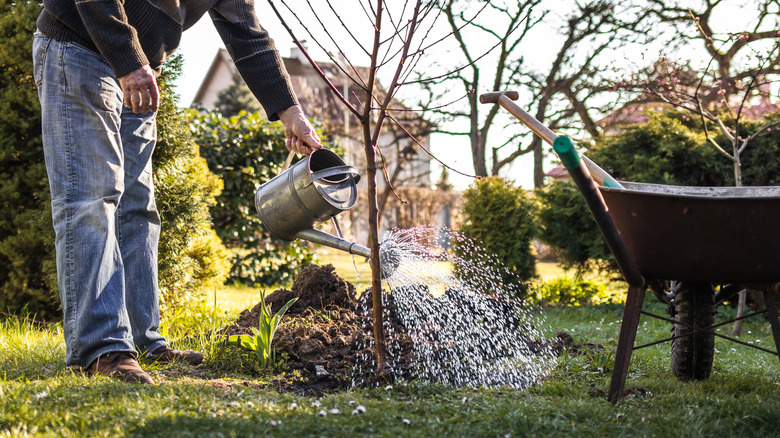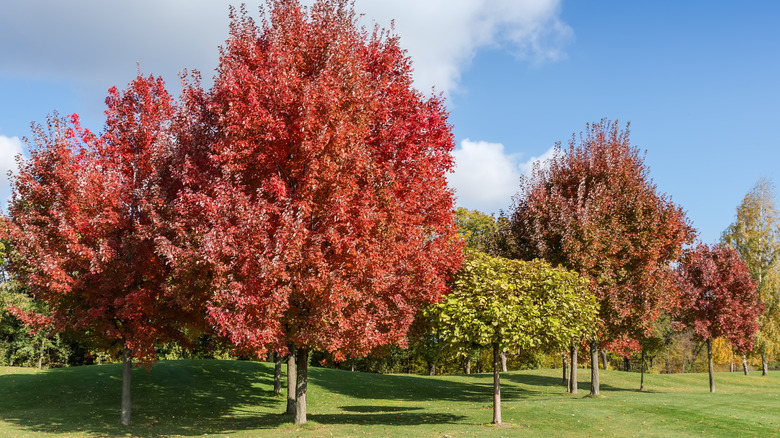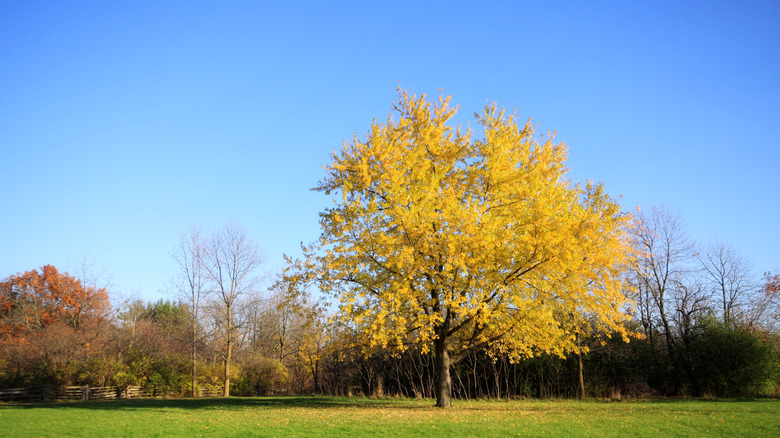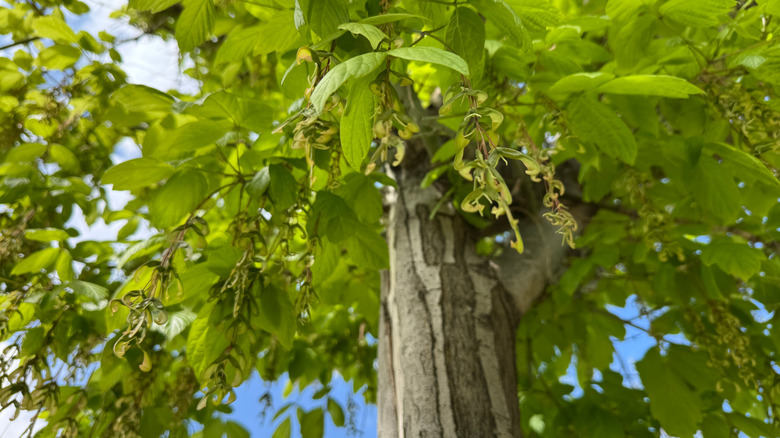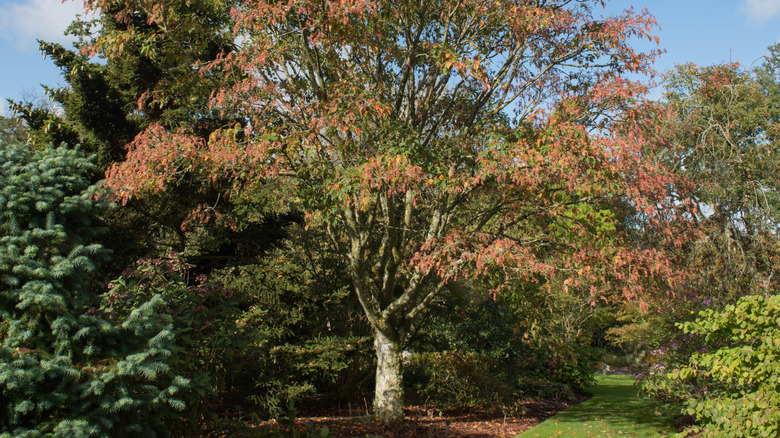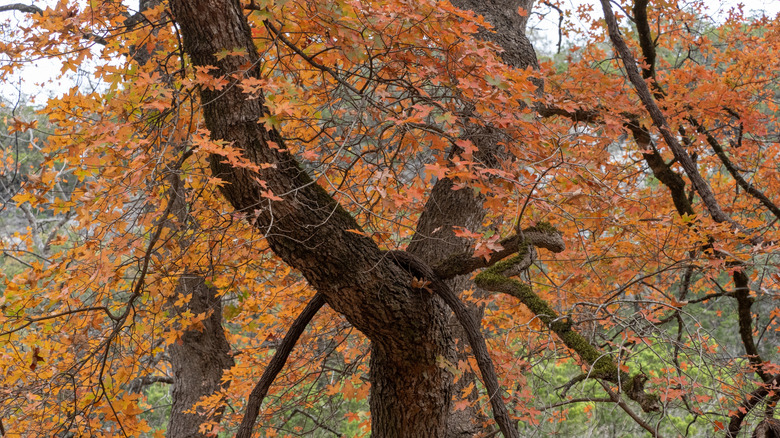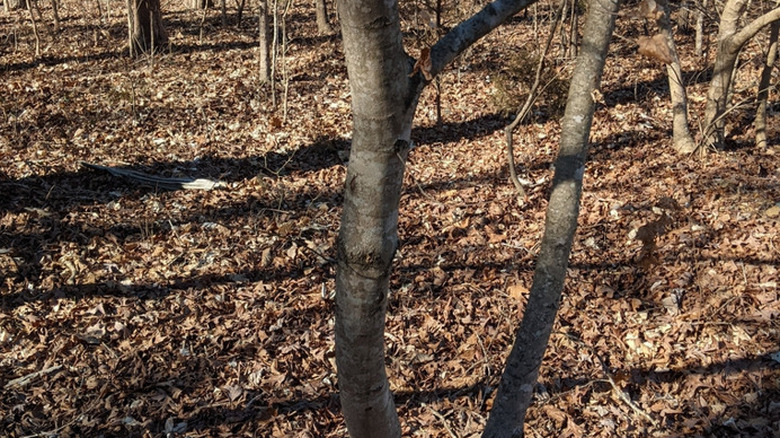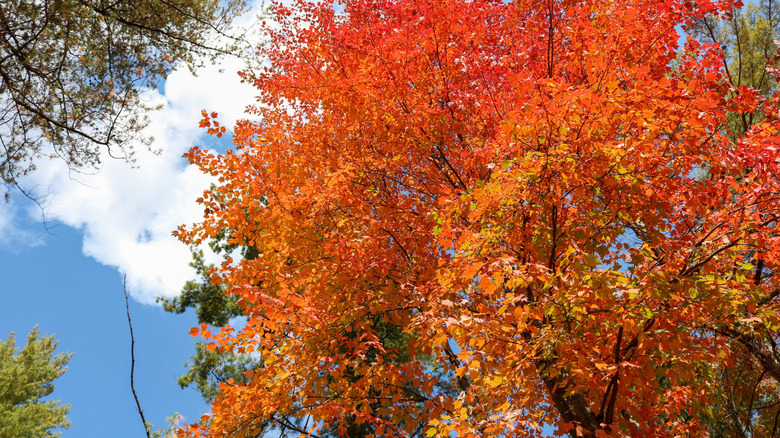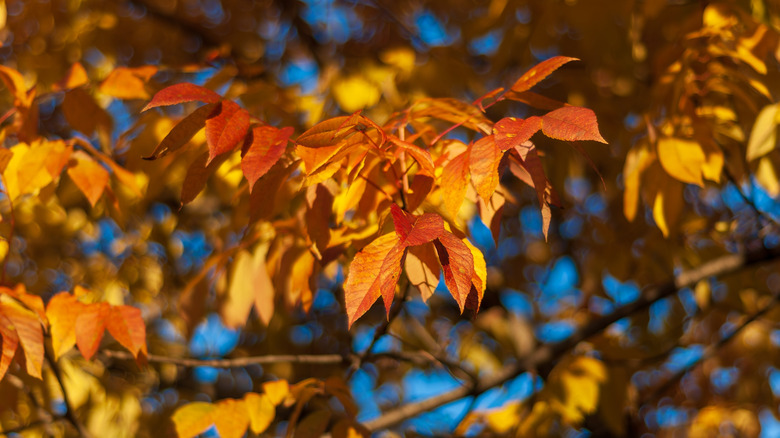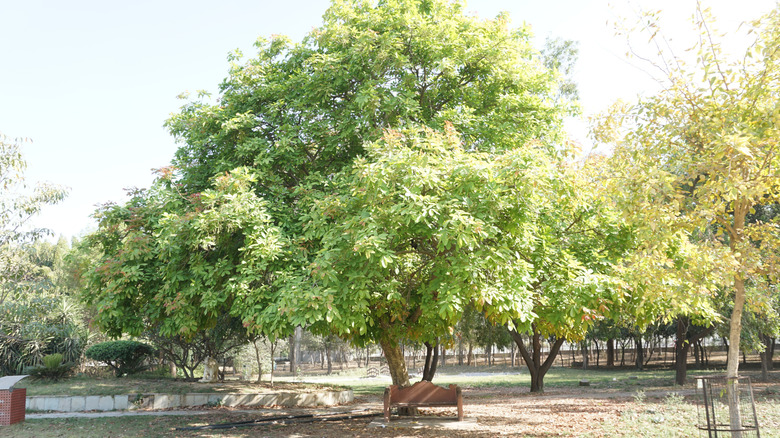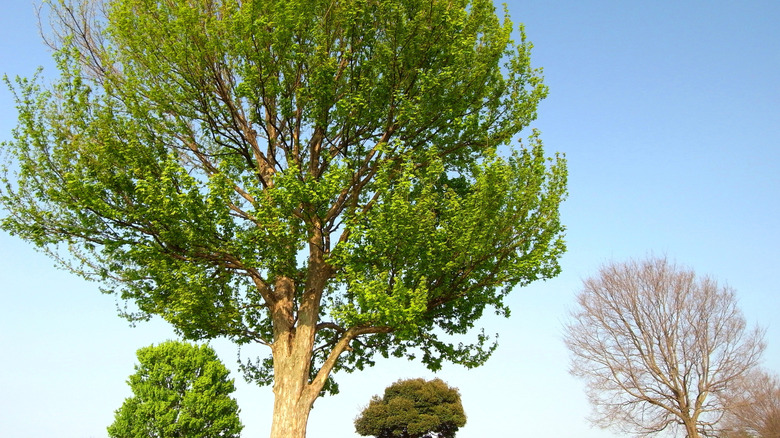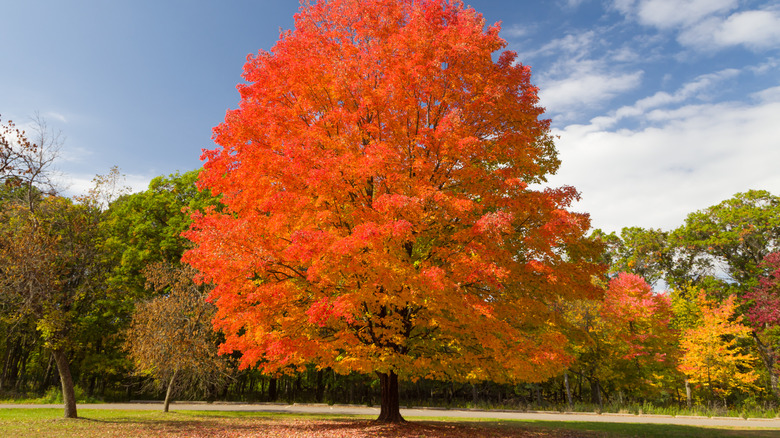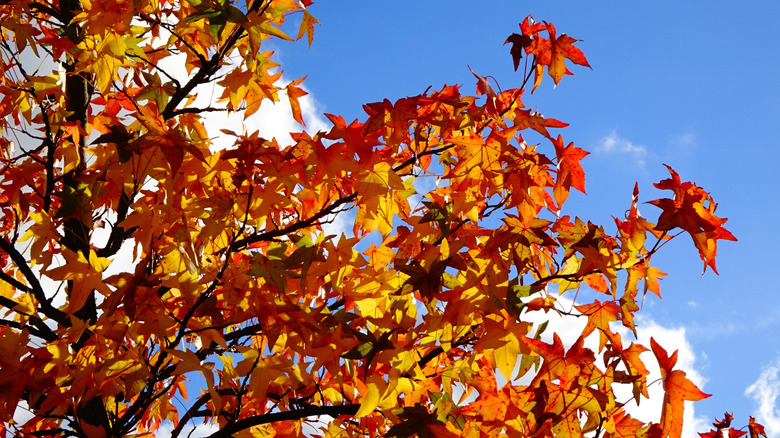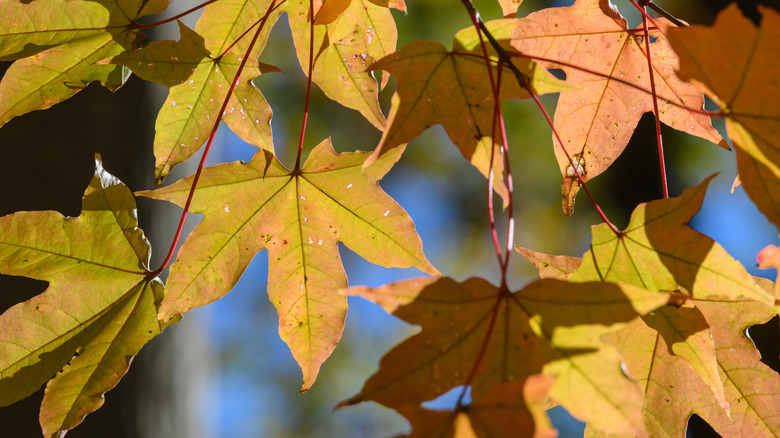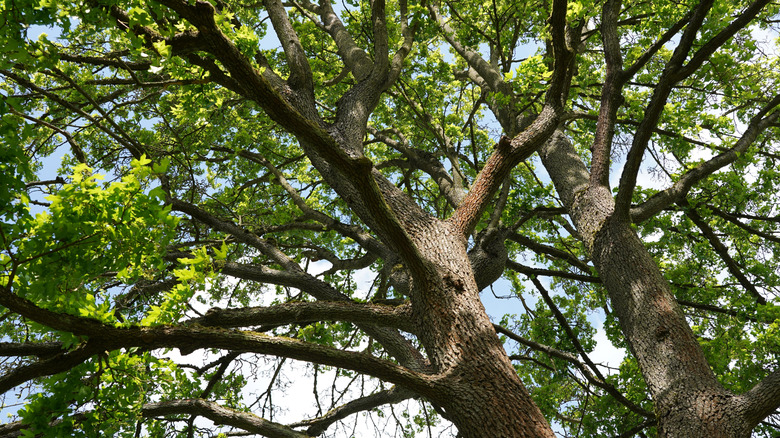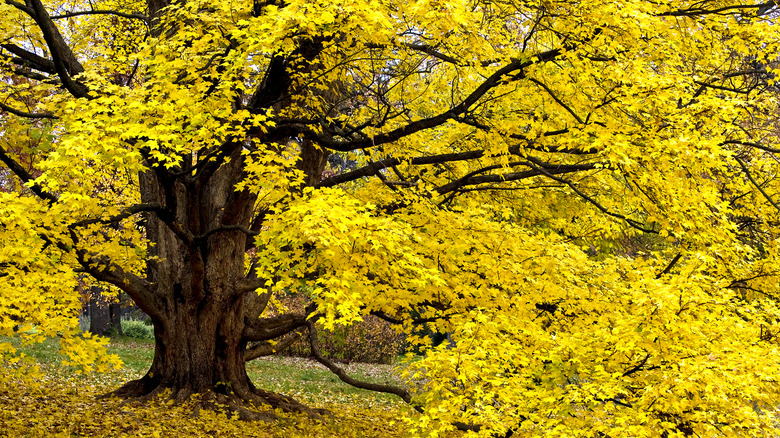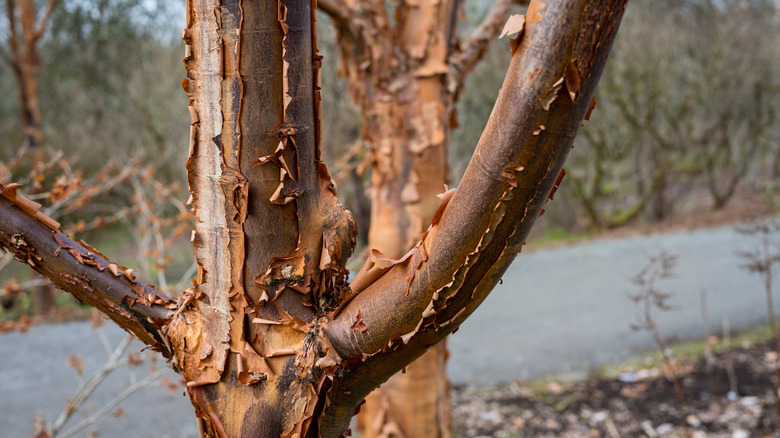The Maple Tree Varieties To Plant In Fall For A Lifetime Of Spring Shade
When it comes to choosing a tree for a landscape, homeowners consider many things. Some plant trees for their aesthetic appeal, while others do so for their fruit. However, there are also many people who just want fast-growing shade trees to cool off a hot backyard. And when it comes to North America, maples are one of the most commonly used shade trees. Examples include painted, silver, red, and black maples. But with nearly 100 species and even more cultivars, how do you choose a maple tree variety for shade? First of all, choose a tree according to your growing zone. Since shade trees are going to be there for the long haul, you want to make sure that they can survive and grow well in your area's climate.
Next, learn about its care, as well as pest or disease problems. If your location is prone to a particular pest or disease of a maple tree, it is better to skip it and choose another species. Tree size plays a huge role, too, when choosing the right maple. For a large shade canopy, choose a variety that matures to at least 40 feet in height and 30 feet in width, but you may need to choose a compact maple variety for smaller spaces.
Also keep in mind that many maple species have shallow and spreading roots that can interfere driveways and foundations. So, you want to make sure that you plant far enough away from your home or pavement to avoid problems later on. And finally, if you would rather skip the extra cleanup, pick a species that drops fewer seeds or produces smaller samaras.
Red maple
Red maple (Acer rubrum) is a stunning maple tree that will add drama to your yard with its beautiful flowers and fall foliage. It grows quickly and establishes easily. You can grow it in USDA Hardiness Zones 3 to 9, and there are many unique cultivars to choose from. It is considered a sturdy shade tree and can reach heights of 60 to 90 feet. And even though it is tolerant of many types of soil, for the best and quickest growth, you should plant it in moist, acidic soil rich in organic matter.
Silver maple
With its quickly branching crown and rapid growing habit, silver maple (Acer saccharinum) is another maple tree variety perfect to plant in fall for spring shade. The tree can add as much as three to seven feet to its height every year and can reach a size of 50 to 80 feet in length and 40 to 60 feet in width. Just like red maple, you can also plant it in zones 3 to 9. Just remember that its wood is weak and breaks easily in winds and under heavy snow load.
Ashleaf maple
Also known as boxelder (Acer negundo), ashleaf maple is commonly found in gardens and parks. For people looking for a tough shade tree, it is a perfect choice. It will survive in dry conditions and even in poor soils anywhere within zones 3 to 9. Furthermore, it establishes quickly, although it doesn't live very long when compared to other maple types. Also, because of its thin bark, it is prone to fire and ice damage. It is also easily infected by boxelder bugs, so keep an eye out for them.
Snake bark maple
The snake bark maple (Acer davidii) gets its common name from the distinct greenish bark of its young stems, marked with narrow white stripes that sort of look like a snake. It grows well in zones 5 to 7 and can reach heights of up to 30 to 50 feet with a canopy width of 20 to 40 feet. As for the soil conditions, it is not very picky when it comes to soil type or pH, but the soil needs to be evenly moist, and it will not survive waterlogged situations.
Bigtooth maple
If any other maple rivals the fall color of a sugar maple, it is probably bigtooth maple (Acer grandidentatum). Not just that. This maple also has a good tolerance against high soil pH, as well as good drought and cold tolerance. Growing best in zones 5 to 8, bigtooth maple can reach heights and widths of up to 30 feet. Now this isn't that big, but it can still offer excellent shade for people with small backyards or gardens. Also, keep in mind that other plants might have a hard time growing under its dense shade.
Chalkbark maple
Chalkbark maple (Acer leucoderme) is another maple with beautiful fall color of its leaves. However, what adds to its fall and winter interest is its chalk white bark on mature trees. It grows best in zones 5 to 9 and can be about 30 feet tall with multiple trunks. The canopy can reach a width of about 25 feet and serves wonderfully as a shade tree. The tree can perform well in dry sites and has medium water needs, but you will need to give it more water if you plant it in sunny places.
Black maple
The species gets its title from its botanical name Acer nigrum. Nigrum in Latin means black, a reference to the tree's dark, blackish bark and twigs. It is ideal for people who are looking for a large shade tree that lives long, as it can survive for up to 200 years. The tree itself can reach a height of 60 to 70 feet with a canopy width of 40 to 60 feet. You can grow it pretty easily in most average soils, and it performs well in zones 5 to 8.
Three-Flower maple
If you are looking for an award-winning maple tree that works great as a shade tree, go with three-flower maple (Acer triflorum). The tree is known for offering multi-season interest and is valued highly as a specimen tree. It has wonderful fall colors with shades of yellow, orange, and red, as well as shaggy, peeling bark, which gives it that rustic look. You can plant it safely in zones 4 to 7 and expect it to attain heights and widths of about 30 feet. Also, it has no serious problems, but it can get verticillium wilt.
Nikko maple
Nikko maple (Acer maximowiczianum) is perfect for people who are looking for a maple shade tree but not the traditional maple leaves. Its leaves are distinct among maples as they are made up of three separate leaflets. The best regions to grow it are those that are located in zones 5 to 7. In addition, the nikko maple can be easily transplanted and has quite good resistance to insect pests. Under ideal conditions, the tree can live for 80 years or more, but unfortunately, it can be a bit slow to establish.
Trident maple
Trident maple (Acer buergerianum) is another shade tree for small areas because of its bushy growth habit. It has three-lobed leaves with the central lobe being the longest, which makes them look a bit like a trident. It can grow up to 30 feet high and wide and performs best in zones 5 to 9. This maple establishes relatively quickly and has a round, full canopy. Furthermore, it adapts easily to many soil types and handles both drought and heat with ease. Just take care during winter, as snow or ice may cause its branches to break.
Sugar maple
It's hard to find a better tree than the sugar maple (Acer saccharum) because it is long-lived, has sturdy wood, offers brilliant fall colors, and has a broad canopy that provides a ton of shade. At maturity, sugar maples are about 40 to 80 feet tall and 30 to 60 feet wide. In spring, the tree also produces small, drooping clusters of greenish-yellow flowers. You can grow it anywhere in zones 3 to 8. It is a slow grower, though growth is faster during the first 35 years. Just keep it away from poorly drained and compacted soils.
Shantung maple
Shantung Maple (Acer truncatum) is a fast-growing maple that is loved for its beautiful colors and compact growth, making it an excellent choice as a shade tree for small places. It grows well in zones 5 to 7 and requires moist and well-drained soils, but will also tolerate moderate droughts. And, even though it grows quickly, it only reaches heights of up to 30 feet. Probably the best feature about this tree is its leaves, which, when they emerge, are sort of reddish and take on a dark green color as they mature.
Painted maple
Painted maple (Acer pictum) has many uses. Some use it as a shade tree, while others grow it as a specimen tree or bonsai. It has a rounded shape and grows about 30 to 35 feet tall with a similar spread. You can grow it anywhere in zones 5 to 8, just make sure that the soil is slightly acidic, well-drained, and evenly moist. Its leaves emerge with a bronze hue in spring, turn bright green in summer, and glow yellow to orange in fall. And the best part is that it doesn't have any serious pest issues.
Field maple
Also known as the hedge maple (Acer campestre), it is a highly valued tree for urban greening. It casts a dense shade, which is a downside to planting a maple tree in your healthy lawn, as it can suppress the growth of grass and other plants beneath. But the good thing is, it can withstand heavy pruning. In terms of height and width, it reaches sizes of up to 35 feet and can be planted safely anywhere in zones 5 to 8. It prefers lime-rich soils but can adapt well to other types, too.
Miyabe maple
The beauty of miyabe maple (Acer miyabei) lies in its wide branches that reach down toward the ground, bark etched in deep, corky ridges, and dense branching, which make it an excellent shade tree. It has low maintenance and water needs, reaches a height and width of about 30 to 40 feet, and you can plant it anywhere in zones 4 to 8. Furthermore, it is more vigorous, tougher, and more adaptable than most others of its kind. Just make sure not to grow in overly dry soils, although it can survive brief periods of drought.
Paperbark maple
With its elegant, papery bark that peels away in layers of warm chestnut brown, the paperbark maple (Acer griseum) is another shade tree that can bring a touch of quiet beauty to any garden. You can grow it in zones 4 to 8. This compact tree can grow to a height and width of 25 and 20 feet, respectively. However, make sure you water it well, as it is pretty intolerant of drought. Other than that, it has very few problems and requires little to no pruning.
